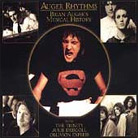March 2004
Auger’s brand of jazz-fusion, like Lifetime’s, has traveled well over the years. But while Lifetime’s music was difficult and required some concentration, you could dance to Brian Auger’s records from the fusion era. Auger anticipated fusion by a couple of years, mixing jazz and pop music in 1967 with the third incarnation of the Brian Auger Trinity. His description of that band, "a combination of blues, Motown, and Messengers," helps explain why it and his most popular band, the Oblivion Express, were so successful. It stands to reason that the jazz component in that description would be Art Blakey’s soulful Jazz Messengers. Blues and R & B have been the core of Auger’s style from the beginning. Disc one of Auger Rhythms begins with three tracks from 1961 by the Tommy Whittle Quartet, with Auger on piano. His liner notes name Horace Silver, Bobby Timmons, and Victor Feldman as influences, but there’s also a strong hint of Ramsey Lewis in his playing. That soul-jazz feel runs through all Auger’s playing and comes into sharp focus with his first appearance on the Hammond organ here, a 1966 recording of Timmons’ "Moanin’." Rock had the upper hand by the time singer Julie Driscoll joined the Brian Auger Trinity in 1967. Auger’s success at adapting well-known rock tunes varied, but when things clicked, as they did on Donovan’s "Season of the Witch" and the Doors’ "Light My Fire," he was able to integrate his improvisational skills as a jazz musician with a straightforward rock beat. Driscoll was a key reason the Trinity’s best records from the late '60s worked so well -- she combined the suave sophistication of jazz with the emotional release of soul. It’s astonishing to me that she’s not better known. A few tunes from this period misfire. The Band’s "This Wheels on Fire," is not the sort of song that fits well with the Trinity’s jazz-and-soul vibe, and "A Day in the Life," from a ’68 Auger solo album, sounds like something Creed Taylor might have imposed on Jimmy Smith. Disc two highlights Brian Auger’s Oblivion Express, where Auger truly hit his stride. Most fusion bands of the time, such as the Mahavishnu Orchestra or Return to Forever, asked you to sit back and admire their technique. The Oblivion Express wanted you to get up and shake your behind. The drums were looser than they were in Auger’s other bands and the bass thumped along more fluidly. Auger gave himself more solo time, but he never seemed to run out of good ideas or feeling, no matter how many solos he took. He made the Hammond organ sound as contemporary as the '70s-era synthesizers he was using then, and he made those sound more soulful than anyone else did. Auger employed two good guitarists in the Express, Jim Mullen and Jack Mills. I give a slight edge to Mills for his funky rhythm-guitar style and his lean, tuneful solos. I never cared for vocalist Alex Ligertwood during his long stint with Santana, but he seems just right for the Oblivion Express. He showed off on occasion, but fusion was show-off music and he had the soulful vocal style the band needed for its R&B-styled songs. Disc two closes with three songs that feature Auger’s children, including a selection from a 1999 Oblivion Express disc, Voices of Other Times. Karma Auger, the drummer on all three tracks, has a good feel for a groove (he also mastered most of Auger Rhythms). Savannah Auger sings on the Oblivion Express tune and Ali Auger closes the set with a standard, "The Lady’s in Love," where her father returns to straight-ahead-jazz piano playing. All three musicians seem to have inherited their father’s talent. I wish Auger had included his 1968 recording of "Bumpin’ of Sunset" in addition to a slower version from a live show in the '70s. I also wish someone had proofed the liner notes more carefully. Many of the personnel listings are hard to match to the tunes, especially when, for example, Phil Kinorra is credited with the drums on tracks 1-5, Mike Scott on tracks 2 and 3, and Mickey Waller on tracks 4-6. And that’s just disc one. Auger’s liner notes clear things up, but only a little. Recording dates and a discography would also have been helpful. In his introductory liner notes, Tom Vickers calls Auger a "…’fire in the belly’ musician who still comes to a gig ready to play." He’s right. I saw Auger ten years ago backing Eric Burden, and every time he soloed it sent a charge through the music. He’s a classy musician, and this is a well-deserved, beautifully presented tribute. GO BACK TO: |
 Brian Auger - Auger
Rhythms: Brian Auger's Musical History
Brian Auger - Auger
Rhythms: Brian Auger's Musical History The booklet that
accompanies Auger Rhythms, the beautifully packaged two-CD overview of keyboard
player Brian Auger’s career, contains a number of tributes from other musicians,
including drummer Tony Williams. Williams compared Auger favorably to organist Larry
Young, who played with Williams in Lifetime, the group that in the late '60s and early
'70s helped set the stage for jazz-fusion. I think the comparison is a bit of a stretch --
Auger’s never taken the organ into the free-jazz realms that Young did -- but he does
play with a drive and intensity that’s similar to Young’s.
The booklet that
accompanies Auger Rhythms, the beautifully packaged two-CD overview of keyboard
player Brian Auger’s career, contains a number of tributes from other musicians,
including drummer Tony Williams. Williams compared Auger favorably to organist Larry
Young, who played with Williams in Lifetime, the group that in the late '60s and early
'70s helped set the stage for jazz-fusion. I think the comparison is a bit of a stretch --
Auger’s never taken the organ into the free-jazz realms that Young did -- but he does
play with a drive and intensity that’s similar to Young’s.